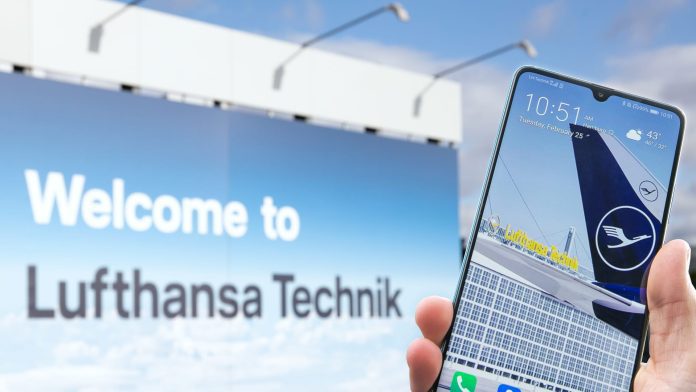This article is taken from a new Enterprise IoT Insights report on Industrial 5G SLAs. The full article, including additional sections, along with the rest of the report – with commentary from the likes of Accenture, Appledore Research, EXFO, Nokia, and Vodafone – is available to download here.
The Lufthansa Technik case study (see link here, and in report) is not the only one; increasing numbers of enterprises are putting private 5G to work. But it was one of the first industrial 5G networks in Europe, and it remains a seminal example of the practical application of cellular in Industry 4.0. Its clarity comes partly just from the fact the two key parties in the project are able to speak about it – because they are part of the same group.
They are not sworn to secrecy, like most paranoid 5G experimenters. Lufthansa Industry Solutions, the second of the two parties involved, has been engaged variously with the rest of industry, as well, offering a 5G consultancy and design service for digitally-minded enterprises of all stripes – though mostly in Germany, and mostly in automotive, logistics, and healthcare.
The firm has around 2,100 staff; last year, 40 percent of its revenues came from inside the Lufthansa group. The rest, the lion’s share, came from selling digital change to others. Here, Claudius Noack, with Lufthansa Industry Solutions, talks about how roles and responsibilities are being divvied up in the wider market.
…

Explain the position of Lufthansa Industry Solutions within the group, and its strategy outside – and something of how 5G fits in.
“Our DNA is in the exchange of knowledge and tech between industries and sectors – such as from the aviation industry to other fields like logistics and automotive, and vice versa. Which is what we’ve done with 5G. But there is no one-size-fits-all system. Which is why we are offering consultation about deploying and designing 5G for industries, with their requirements in mind.
“It requires a broader view – you have to check if 5G is the right fit. There are use cases that work well with Wi-Fi, or with fibre… You need to know about the different setups, which is something the vendors and carriers don’t right now. They need more practical experience. They know how to build networks for millions of devices, and they are trying to scale-down for industry.
“But most industries don’t just need scaled-down versions. Which is where we come into play – to [help] design industrial networks. It might be different in a few years. But for now, you need a partner with experience.”
Which industrial sectors are most interested in industrial 5G right now?
“The automotive sector is very interested; the same with logistics. There is a growing appetite within the pharmaceutical industry, to keep up with processes – especially since the pandemic. Those companies have the money right now, and they know they need to do something – to be better connected. They want their production sites to be automated, to switch production more easily.
“I was on one project where the customer was changing production every three months, and reorganising their whole setup every time – physically changing things from left to right. So having everything on 5G has helped a lot. Flexibility is usually the thing. You read about 5G robots, and sub-millisecond latencies, but we haven’t seen much demand. Right now, the demand is for [reliable] connectivity and coverage.”
Talk a little more about the use cases, and how this technology is being deployed.
“The big thing is just that you can create your own standalone network. Before, you needed a carrier, and it was always a public network; yes, you could get some indoor antennas, but it wasn’t your network. That is the biggest change. Yes, there is more bandwidth, and there are cases where you need that – such as if you’re streaming CAD data. But that’s not the case, mainly. And yes, you get lower latency, which gets talked about all the time, but all of our projects so far would be fine with LTE.
“Latency on public LTE is 40ms; we get to 15ms on non-standalone 5G, and 7ms on standalone 5G – with no spikes. But we have never needed latency of 1ms, and not even 5ms. The only reason we don’t use LTE – because it would be much cheaper to go with public LTE – is that we need to go indoors, and once you enter a production facility that 40ms latency goes up to 100ms and that 100Mbps downlink goes down to 10Mbps.”
What about demand for hybrid networks, crossing into public 5G?
“So far, our projects have been one or the other. We have done projects with big telcos, for outdoor 5G. The others have required edge compute setups, where you don’t want data floating around the internet, and where 5G has been used for the last-metre to and from the edge computers, usually for AI image processing for quality checks.
“But there is a different setup for each use case. Right now, the systems are designed to deliver for one or two use cases, and not more. We are not at a stage where we need to slice the network for different things – a slice for edge computing and another for calls and video, or other stuff. That will come, but it will take two years.”
Talk about the kinds of KPIs these use cases require, and how they are being written into SLAs – and who will write them?
“For all our cases, but especially the one with Lufthansa Technik, which is business critical and which I can talk about, we have had zero minutes of unwanted downtime. Yes, we did some updating, so it was down for a minute or so. But zero minutes in over a year. But the question about who manages the network is fair. Because right now our own people are managing these networks. We get called when there is an issue.
“And given the projected growth, additional support could be required to manage these requests. In the end, these industries will likely do it themselves. That is our approach – to enable companies to be autonomous. What happens is we set the KPIs around the use cases in the design phase, and write them into the RFPs that go out for the build phase, so they are guaranteed in the contract.
“But then the network is set up, and there is no SLA to speak of. That has been the case so far, in 12 months of doing this. Even the vendors are struggling with the question of SLAs, and who will manage the networks in the long term. They know they need to find a solution. [But] the systems are not complex enough yet. We are not talking about ultra low-latency, or even big bandwidth; just about connectivity – which is how 5G is helping right now.”
So Lufthansa Industry Solutions doesn’t wish to manage – just to consult and design?
“Yes. The first step is use-case identification; the second is technology matching; the third, the most important right now, is finding the right supplier. After that, the fourth step is around legal support and applying for frequencies, which is not that complicated, and the final step is deployment, which basically involves talking to electricians. It is basically project management, but you need to know the tech, and what it’s for. Those are the things. After it is deployed, we go to the next project.”
Do you expect companies like Accenture and IBM to handle the management? Or can you see vendors and operators being involved?
“Yes; like if IBM, which is doing a lot of networks, had a 5G department. Right now, it takes a lot of effort to carve out these capabilities from operators, and a lot of coordination with [vendors]. Nokia and Ericsson have these cloud systems, which can help, because customers sometimes want to connect from anywhere.
“But we usually ask those providers to create a cloud platform on site… The smaller the company gets, the more likely they will want a third-party service provider to manage the network. When you talk to the big ones, like Lufthansa, they will manage their own networks by themselves. If they can find the right people.”
What demand are you seeing for ultra-reliability, as prescribed in the 5G standard?
“Everyone asks about reliability, but when you explain redundancy costs money, they hold back, and go with the simple version, just to try it out. The other thing with 5G redundancy is you need space – and lots of it, for all the server racks. Customers don’t have lots of space.
“And I have not yet found a project yet where it is 24/7 business-critical; where they have said, ‘If this is offline for even a minute, the business will go bankrupt’. Usually they just want to add 5G to their normal setup, and switch from Wi-Fi.”
Should carriers focus on public networks and industrial crossover into their domain?
“Yes, because most industrial 5G use cases are for indoor connectivity, which doesn’t need a carrier. There will be plenty of use cases that require outdoor coverage, and roaming between, and cases where enterprises want a slice for normal things, like calls and conferences. So they will get a share of the industrial market, for sure.”

